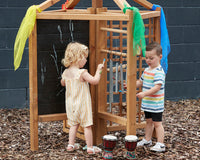My (Musical) Theory of Relativity
As with all musical instruments, they all require a certain level of technique, practise and dedication to achieve an acceptable result. The more practise and performing, the better the result and progress towards virtuosity. As Roy Castle once sang, “Dedication, that’s all you need”!
Woodwind and brass instruments require a technique of sound production prior to any method of note alteration, due to their reeds and mouthpieces. Whereas some instruments can produce a perfect, tonally acceptable sound immediately, with no prior learning, the trombone has a mouthpiece with which sound must be initiated.
Think of drums, percussion, guitar, (pizzicato) strings, piano and bag pipes! They can all be played by anyone straight away. Obviously, to progress to a musical level of proficiency on these instruments, and to fully explore their full potential and musical range, you must learn and improve your technique, tonal quality and interpretation.
Get the Buzz
So, I digress no more. Is it hard to learn to play the trombone? The trombone is simple in its design; 9 feet of brass tubing with a slide section to alter the tubing length, which lowers and raises the pitch. No valves to change note, no keys to distract you, and a sound so deep and prominent that trombonists can stir audiences and petrify conductors!!
To produce the initial sound, as on all brass instruments, you need to get ‘the buzz’. The method of synchronising the lips, by vibrating the airflow through a correct embouchure and varying the pressure to alternate the pitch. Or put simply, blowing a raspberry! It’s always good to learn this ‘buzzing’ method before applying the mouthpiece. It doesn’t take long.
Tongue in Cheek
Once the initial sound is produced, it is time to move on to changing the pitch/notes. Unlike any other instrument, the trombone has a slide to achieve this. As you move the slide out, it lowers the pitch, and vice versa for when you move it back in, it raises the pitch.
The tongue is very important as well, as this articulates the notes and stops the airflow, producing the desired length of note, from short staccato to longer legato values. A dedicated brass or trombone teacher is invaluable when first learning. Your teacher is much better than reading tutorials, as they can both see and hear exactly what you need to do to improve your tone and technique. When I started, it took me about 3 months to go from ‘can’t get a note’, to ‘Geno’ by Dexy’s! Yes, it will sound a bit ‘rough’ and rasping, for another few months, until your lips and mouth muscles get used to the position and pressure, but with more practise, the tone WILL improve, and before long you will be playing great tunes.
Trombonology
I have often been asked, “how do you know what position to put the slide”? Unlike other brass and woodwind instruments, which have specific valves or keys to press either singularly or in combination, the trombone has a long, free-flowing slide with 7 positions.
The correct position is simply down to muscle memory and practise. Trust me, after a few months it becomes second nature, that when you see a specific note, you automatically put the slide in that position. Your ‘eye to mouth to ear to arm’ coordination will be trained to make it a natural movement. Practise, practise, practise! (If you want to improve your overall tone and volume production quicker, I strongly recommend a practise mute!).
Funny ‘Bones
The trombone is unique in that it can ‘slide’ seamlessly from note to note with no interruption. This has led to great compositional variety over the years from many of the greatest composers. But in my (biased) opinion, it is the purest, greatest of instruments. Sonically imposing, technically impressive, and musically leading in all that it undertakes. The trombone, when played, is never ignored!  I would advise any ‘new’ trombonist to join a band/orchestra/group as soon as possible. Don’t worry if you can only play a few ‘rasping’ notes and you think you are not ready. YOU ARE! And, I promise you, you will enjoy it and I guarantee your playing will improve 10 times quicker!
I would advise any ‘new’ trombonist to join a band/orchestra/group as soon as possible. Don’t worry if you can only play a few ‘rasping’ notes and you think you are not ready. YOU ARE! And, I promise you, you will enjoy it and I guarantee your playing will improve 10 times quicker!
If you want to treat yourself to a lovely new trombone, I can assure you that the Montreux Trombone is the finest, best value for money trombone on the market. It will not let you down, plus, you may be able to rent one from us via your school as part of our amazing rental scheme.
Sliding Summary
Is it hard to learn to play the trombone? I would honestly say, it is no harder or easier to play than any other wind or string instrument. They all need a specific technique and dedication to sound great (bag pipes excluded!).
Having a trombone teacher is very important, as is joining a band as quickly as possible. As you progress and improve, I recommend you take some grades so you can officially be rewarded and see your improvement. I would estimate a time-scale of grades in the region of; Grade 1 after 12 months playing, Grade 3 after 2-3 years playing, Grade 5 after 4-5 years playing and Grade 8 after 6-8 years playing. These are simply estimates in my experience and I know students who have achieved Grade 8 after only 5 years of playing (and that was on Montreux Trombone!) and a friend of mine who has been playing for 20 years, and he is still only Grade 5 standard! (no names mentioned...Simon!) So, if you are considering playing a trombone. Just ‘Do It’! You will never regret it.




















